My hostel at Venezia, Residenza Santa Croce, was a delightful surprise. Conveniently located near the Santa Lucia Station, it had a nice room and a, by hostel standard, huge bathroom. The staff was very helpful: She not only gave me a free map (Yes!) immediately but also gave me very detailed information about major attractions, transportation, walking trails and so on. But the most interesting thing was still to come.
After I introduced myself to my fellow hostelers, I hesitantly asked two Californian girls, Sydney and Roxanna, whether we met before. They didn't think so, of course. But when I reminded them that we might have seen each other two days before in Nice, they recalled. After further confirmation of the name of the hostel in Nice, we started to laugh. As if two same hostels wasn't enough, we exchanged further travel plans and found out that we booked the same hostel in Roma, too! What a coincident! (Well, considering the fact that we were all "planning freaks" and probably used similar websites to choose and to compare hostels, it actually all made sense.) By the way, I met another Australian guy, David, in the same room only to find out we booked the same hostel in Firenze. You've got to admire the power of Internet!
The next morning I couldn't wait to get up. With a map in hand, I walked in the city with full confidence. As a major Catholic city in the medieval world, Venezia has many many churches. Starting from the train station, the Church of Santa Maria di Nazareth was the first in sight.
I walked over and took a close look at it.
I knew that I was really quite early because the streets hadn't been packed by my fellow tourists, who certainly would.
As you might already know (duh!), the canal was the streets in Venezia and the gondolas were the BMWs without wheels.
While enjoying the quietness of the morning, I noticed the problem: Many buildings were not well lit. So I quickly decided that I would go through the city at least twice.
Therefore many pictures of the same place were actually taken at different times in the day and I took effort to organize them in a better way, like to put pictures of gondolas together.
It didn't take me much time to reach the heart of Venezia, Piazza San Marco, where the Basilica di San Marco was located.
The Winged Lion with a book is the symbol of San Marco, the patron saint of the city of Venice. I wouldn't be surprised if someone told me that there were more than a thousand Winged Lions in Venezia.
A statue of San Marco prominently stood on the top of the Basilica.
The exterior of the Basilica was heavily decorated with beautiful frescos...
...and colorful pillars.
The interior was equally magnificent.
The color of gold reminded people how rich the Doge and the Venetian merchants used to be.
Even a sewer was brilliantly sculpted.
The splendor didn't stop at the corner.
This is my favorite. I took it over a gate just across the street when I was waiting in the line to ascend the Campanile.
Now a picture of the Piazza San Marco, or the people therein.
The Campanile, or Bell Tower of San Marco was the highest building in the city.
A closer look of the top.
A little walk from the Piazza took you to the waterfront. The view of the sea was simply amazing. On the left was the Doge's Palace and on the right, Biblioteca Marciana.
The space in between was called "Piazzetta San Marco". These pictures were taken from the patio on the second floor of the San Marco Basilica.
The Biblioteca Marciana with its statues.
The Doge was piously kneeling in front of the Winged Lion on top of the entrance.
The palace was surely one of its kind. You can't forget it once you see it.
With €11 you could get a museum card which was good for four museums in the Piazza San Marco. I knew I wouldn't have time to visit all of them but the Doge's Palace was, in a rather trite expression, a "must-see". So I walked into the Palace and was stunned: French Kings might have had bigger gardens but the Doge wasn't short of spectacle, either. They didn't allow photography inside the rooms but this stairs would give you some ideas of what I am talking about.
This was the view of the courtyard.
And this was a sunny corridor.
After you walked through the Doge's numerous rooms, you would come across the famous "Bridge of Sighs", which lead to the infamous prison.
The prison contrasted vastly with the Palace so I looked out of the iron windows to see what a prisoner would have seen.
Another view right from the bridge itself.
The bridge from a different angle. I walked through the prison cells very quickly because it horrified me.
After the prison, it was the Palace again. The beautiful statues looked great from any perspective.
Then I left the Palace altogether, full of awe.
Besides walking, the best way to get around Venezia was, what else, by boat. If you have some money to spend, try the gondolas; otherwise, take the convenient water bus like I did. I followed the advice to buy a day pass so I could hop and ride. The busiest route was No.1, which took me to the Basilica di Santa Maria della Salute, or just "Salute".
It was a beautiful church with a rotunda.
Somehow I got the impression that Catholicism put a lot of emphasis on Santa Maria/Virgin Mary.
I would have tried a gondola if I wasn't traveling alone. The Grand Canal was bigger than I had thought.
I took the bus towards the train station, enjoying the amazing view from the water. This wooden bridge was Ponte Accademia, one of the only three bridges on the Canal Grande.
Among the three, Rialto Bridge was undoubtedly the most famous and most phtographed.
I stopped by and bravely dived into the crowd on the bridge.
On the bridge, an amazing view of the Canal Grande. By the way, I cropped this picture in 1280x854, ready for my 15" Powerbook G4 to use as a wallpaper.
You might have noticed that I seldom took portraits, simply because it was much harder. But I certainly would like to try whenever I could.
I had some good Italian food for lunch with a very reasonable price, thanks to the tips from my hostel staff. Then I walked once again from the train station to the Piazza San Marco, this time by a different route in order to see as much Venezia as possible. As expected, thousands of gift stores selling all things Venezia. These beautiful masks were made for the Venetian Carnival. I didn't even bother to ask the prices.
To wrap up my photo tour, I gave you four panoramic pictures I took from the Campanile. This was the Piazzetta, if you remember.
This was the left side of the Piazza, including the Clocktower, not to be confused with the Bell Tower/Campanile, where I was standing.
This was the port where cruise ships as well as water buses would stop by.
Finally the domes of the San Marco.
There were still so many places to visit in Venezia. For example, I had no time for Lido or Murano at all. Even though I had high expectation for Venezia (who doesn't?), it still managed to amaze me. For a backpacker, Venezia is the dream city: Small enough to explore almost entirely on foot but rich enough to provide three days' entertainment of sightseeing, easily. I now understand why Marco Polo would risk his life to travel for years back to it. I *am* Marco Polo, only in a reverse direction.
The only thing I would complain about it was that there were way too many people. But well, that wasn't Venezia's fault, was it? I wish I had more than one day there. But again, it only gave me more compelling reasons to come back.
After I introduced myself to my fellow hostelers, I hesitantly asked two Californian girls, Sydney and Roxanna, whether we met before. They didn't think so, of course. But when I reminded them that we might have seen each other two days before in Nice, they recalled. After further confirmation of the name of the hostel in Nice, we started to laugh. As if two same hostels wasn't enough, we exchanged further travel plans and found out that we booked the same hostel in Roma, too! What a coincident! (Well, considering the fact that we were all "planning freaks" and probably used similar websites to choose and to compare hostels, it actually all made sense.) By the way, I met another Australian guy, David, in the same room only to find out we booked the same hostel in Firenze. You've got to admire the power of Internet!
The next morning I couldn't wait to get up. With a map in hand, I walked in the city with full confidence. As a major Catholic city in the medieval world, Venezia has many many churches. Starting from the train station, the Church of Santa Maria di Nazareth was the first in sight.
I walked over and took a close look at it.
I knew that I was really quite early because the streets hadn't been packed by my fellow tourists, who certainly would.
As you might already know (duh!), the canal was the streets in Venezia and the gondolas were the BMWs without wheels.
While enjoying the quietness of the morning, I noticed the problem: Many buildings were not well lit. So I quickly decided that I would go through the city at least twice.
Therefore many pictures of the same place were actually taken at different times in the day and I took effort to organize them in a better way, like to put pictures of gondolas together.
It didn't take me much time to reach the heart of Venezia, Piazza San Marco, where the Basilica di San Marco was located.
The Winged Lion with a book is the symbol of San Marco, the patron saint of the city of Venice. I wouldn't be surprised if someone told me that there were more than a thousand Winged Lions in Venezia.
A statue of San Marco prominently stood on the top of the Basilica.
The exterior of the Basilica was heavily decorated with beautiful frescos...
...and colorful pillars.
The interior was equally magnificent.
The color of gold reminded people how rich the Doge and the Venetian merchants used to be.
Even a sewer was brilliantly sculpted.
The splendor didn't stop at the corner.
This is my favorite. I took it over a gate just across the street when I was waiting in the line to ascend the Campanile.
Now a picture of the Piazza San Marco, or the people therein.
The Campanile, or Bell Tower of San Marco was the highest building in the city.
A closer look of the top.
A little walk from the Piazza took you to the waterfront. The view of the sea was simply amazing. On the left was the Doge's Palace and on the right, Biblioteca Marciana.
The space in between was called "Piazzetta San Marco". These pictures were taken from the patio on the second floor of the San Marco Basilica.
The Biblioteca Marciana with its statues.
The Doge was piously kneeling in front of the Winged Lion on top of the entrance.
The palace was surely one of its kind. You can't forget it once you see it.
With €11 you could get a museum card which was good for four museums in the Piazza San Marco. I knew I wouldn't have time to visit all of them but the Doge's Palace was, in a rather trite expression, a "must-see". So I walked into the Palace and was stunned: French Kings might have had bigger gardens but the Doge wasn't short of spectacle, either. They didn't allow photography inside the rooms but this stairs would give you some ideas of what I am talking about.
This was the view of the courtyard.
And this was a sunny corridor.
After you walked through the Doge's numerous rooms, you would come across the famous "Bridge of Sighs", which lead to the infamous prison.
The prison contrasted vastly with the Palace so I looked out of the iron windows to see what a prisoner would have seen.
Another view right from the bridge itself.
The bridge from a different angle. I walked through the prison cells very quickly because it horrified me.
After the prison, it was the Palace again. The beautiful statues looked great from any perspective.
Then I left the Palace altogether, full of awe.
Besides walking, the best way to get around Venezia was, what else, by boat. If you have some money to spend, try the gondolas; otherwise, take the convenient water bus like I did. I followed the advice to buy a day pass so I could hop and ride. The busiest route was No.1, which took me to the Basilica di Santa Maria della Salute, or just "Salute".
It was a beautiful church with a rotunda.
Somehow I got the impression that Catholicism put a lot of emphasis on Santa Maria/Virgin Mary.
I would have tried a gondola if I wasn't traveling alone. The Grand Canal was bigger than I had thought.
I took the bus towards the train station, enjoying the amazing view from the water. This wooden bridge was Ponte Accademia, one of the only three bridges on the Canal Grande.
Among the three, Rialto Bridge was undoubtedly the most famous and most phtographed.
I stopped by and bravely dived into the crowd on the bridge.
On the bridge, an amazing view of the Canal Grande. By the way, I cropped this picture in 1280x854, ready for my 15" Powerbook G4 to use as a wallpaper.
You might have noticed that I seldom took portraits, simply because it was much harder. But I certainly would like to try whenever I could.
I had some good Italian food for lunch with a very reasonable price, thanks to the tips from my hostel staff. Then I walked once again from the train station to the Piazza San Marco, this time by a different route in order to see as much Venezia as possible. As expected, thousands of gift stores selling all things Venezia. These beautiful masks were made for the Venetian Carnival. I didn't even bother to ask the prices.
To wrap up my photo tour, I gave you four panoramic pictures I took from the Campanile. This was the Piazzetta, if you remember.
This was the left side of the Piazza, including the Clocktower, not to be confused with the Bell Tower/Campanile, where I was standing.
This was the port where cruise ships as well as water buses would stop by.
Finally the domes of the San Marco.
There were still so many places to visit in Venezia. For example, I had no time for Lido or Murano at all. Even though I had high expectation for Venezia (who doesn't?), it still managed to amaze me. For a backpacker, Venezia is the dream city: Small enough to explore almost entirely on foot but rich enough to provide three days' entertainment of sightseeing, easily. I now understand why Marco Polo would risk his life to travel for years back to it. I *am* Marco Polo, only in a reverse direction.
The only thing I would complain about it was that there were way too many people. But well, that wasn't Venezia's fault, was it? I wish I had more than one day there. But again, it only gave me more compelling reasons to come back.

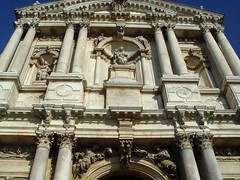
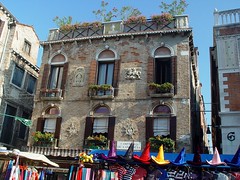
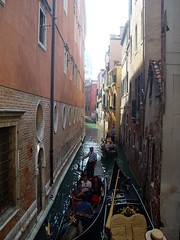
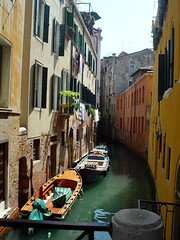
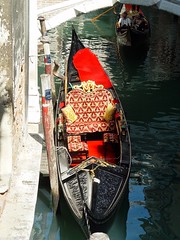
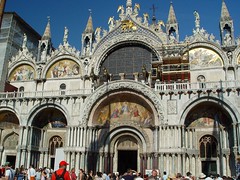

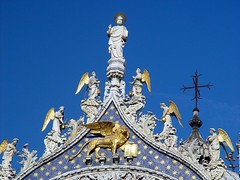

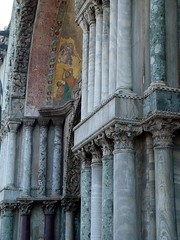

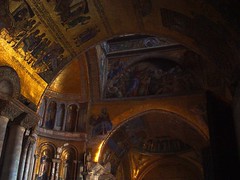

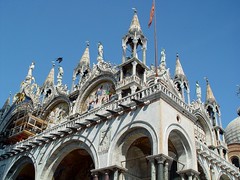
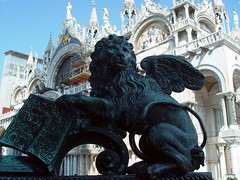
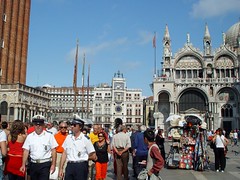
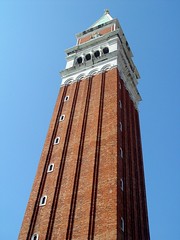
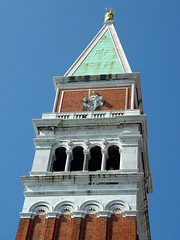


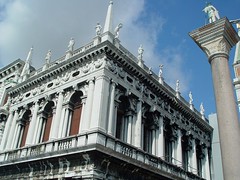

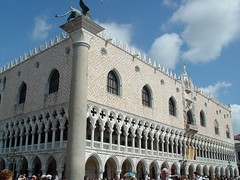

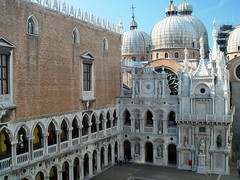
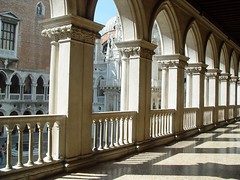
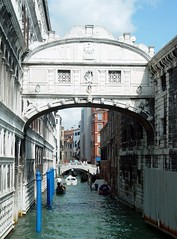
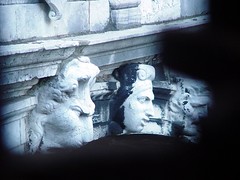

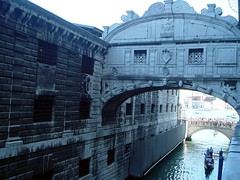
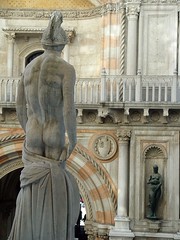
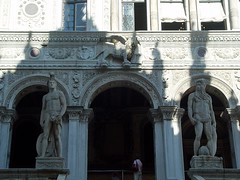

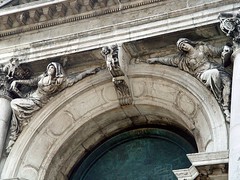

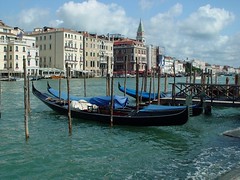


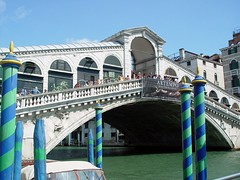


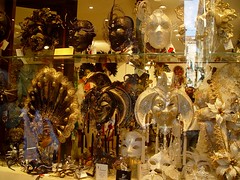
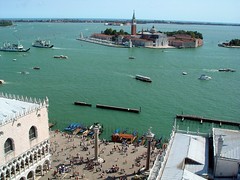
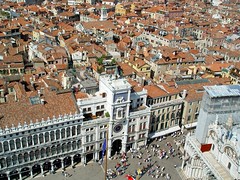
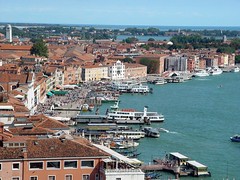

Comments